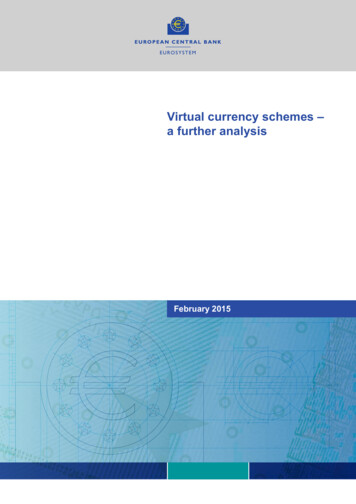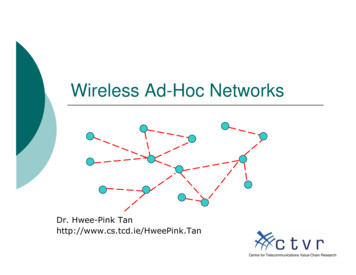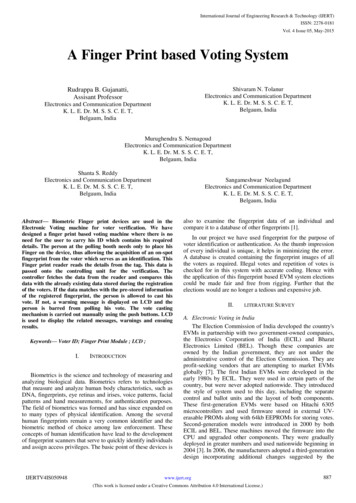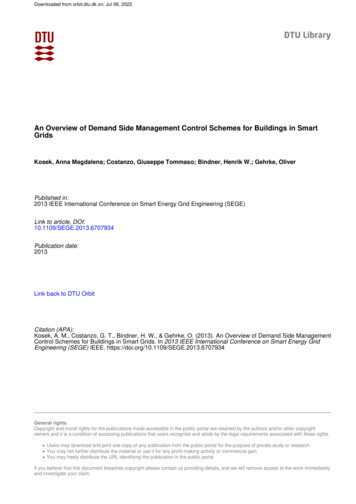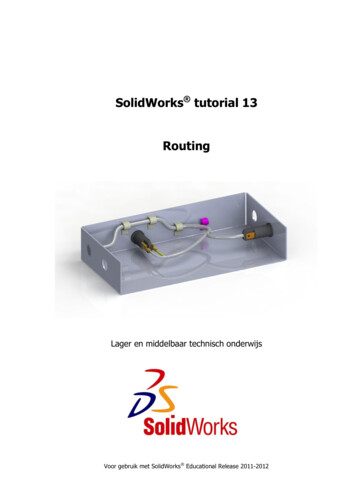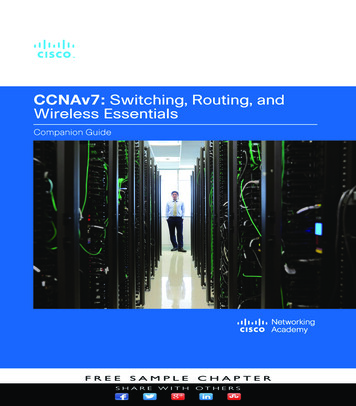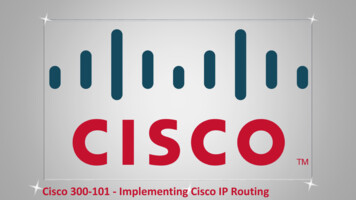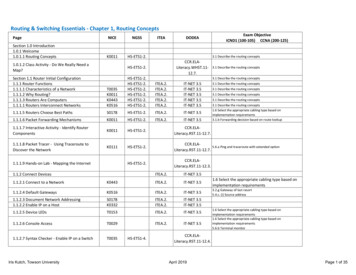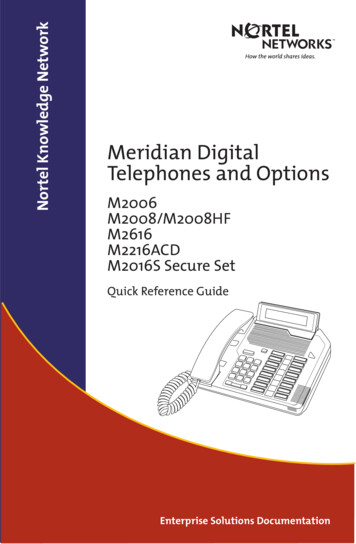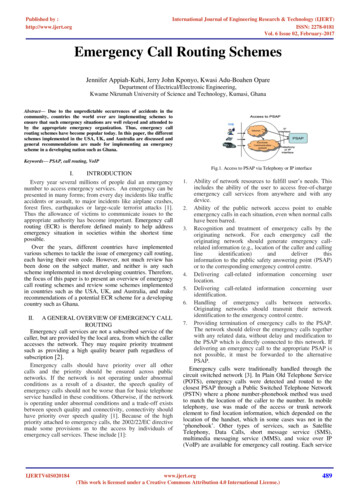
Transcription
International Journal of Engineering Research & Technology (IJERT)ISSN: 2278-0181Vol. 6 Issue 02, February-2017Published by :http://www.ijert.orgEmergency Call Routing SchemesJennifer Appiah-Kubi, Jerry John Kponyo, Kwasi Adu-Boahen OpareDepartment of Electrical/Electronic Engineering,Kwame Nkrumah University of Science and Technology, Kumasi, GhanaAbstract— Due to the unpredictable occurrences of accidents in thecommunity, countries the world over are implementing schemes toensure that such emergency situations are well relayed and attended toby the appropriate emergency organization. Thus, emergency callrouting schemes have become popular today. In this paper, the differentschemes implemented in the USA, UK, and Australia are discussed andgeneral recommendations are made for implementing an emergencyscheme in a developing nation such as Ghana.Keywords— PSAP, call routing, VoIPFig.1. Access to PSAP via Telephony or IP interfaceI.INTRODUCTIONEvery year several millions of people dial an emergencynumber to access emergency services. An emergency can bepresented in many forms; from every day incidents like trafficaccidents or assault, to major incidents like airplane crashes,forest fires, earthquakes or large-scale terrorist attacks [1].Thus the allowance of victims to communicate issues to theappropriate authority has become important. Emergency callrouting (ECR) is therefore defined mainly to help addressemergency situation in societies within the shortest timepossible.Over the years, different countries have implementedvarious schemes to tackle the issue of emergency call routing,each having their own code. However, not much review hasbeen done on the subject matter, and neither is any suchscheme implemented in most developing countries. Therefore,the focus of this paper is to present an overview of emergencycall routing schemes and review some schemes implementedin countries such as the USA, UK, and Australia, and makerecommendations of a potential ECR scheme for a developingcountry such as Ghana.II.A GENERAL OVERVIEW OF EMERGENCY CALLROUTINGEmergency call services are not a subscribed service of thecaller, but are provided by the local area, from which the calleraccesses the network. They may require priority treatmentsuch as providing a high quality bearer path regardless ofsubscription [2].Emergency calls should have priority over all othercalls and the priority should be ensured across publicnetworks. If the network is not operating under abnormalconditions as a result of a disaster, the speech quality ofemergency calls should not be worse than for basic telephoneservice handled in these conditions. Otherwise, if the networkis operating under abnormal conditions and a trade-off existsbetween speech quality and connectivity, connectivity shouldhave priority over speech quality [1]. Because of the highpriority attached to emergency calls, the 2002/22/EC directivemade some provisions as to the access by individuals ofemergency call services. These include [1]:IJERTV6IS020184Ability of network resources to fulfill user’s needs. Thisincludes the ability of the user to access free-of-chargeemergency call services from anywhere and with anydevice.2. Ability of the public network access point to enableemergency calls in each situation, even when normal callshave been barred.3. Recognition and treatment of emergency calls by theoriginating network. For each emergency call theoriginating network should generate emergency callrelated information (e.g., location of the caller and n to the public safety answering point (PSAP)or to the corresponding emergency control centre.4. Delivering call-related information concerning userlocation.5. Delivering call-related information concerning useridentification.6. Handling of emergency calls between networks.Originating networks should transmit their networkidentification to the emergency control centre.7. Providing termination of emergency calls to the PSAP.The network should deliver the emergency calls togetherwith any related data, without delay and modification tothe PSAP which is directly connected to this network. Ifdelivering an emergency call to the appropriate PSAP isnot possible, it must be forwarded to the alternativePSAP.Emergency calls were traditionally handled through thecircuit switched network [3]. In Plain Old Telephone Service(POTS), emergency calls were detected and routed to theclosest PSAP through a Public Switched Telephone Network(PSTN) where a phone number-phonebook method was usedto match the location of the caller to the number. In mobiletelephony, use was made of the access or trunk networkelement to find location information, which depended on thelocation of the handset, which in some cases was not in the‘phonebook’. Other types of services, such as SatelliteTelephony, Data Calls, short message service (SMS),multimedia messaging service (MMS), and voice over IP(VoIP) are available for emergency call routing. Each service1.www.ijert.org(This work is licensed under a Creative Commons Attribution 4.0 International License.)489
Published by :http://www.ijert.orgInternational Journal of Engineering Research & Technology (IJERT)ISSN: 2278-0181Vol. 6 Issue 02, February-2017type may have its own interface to the PSAP. For instance,POTS used the PSTN interface, as mentioned above.Irrespective of the type of service that hosts the emergencyservice or the type of interface that links the caller to thePSAP, an emergency call routing service must perform threebasic functions [3]:1. Routing to the appropriate PSAP (as defined by therelevant authority).2. Identification of the caller (network identity throughe.g. network time protocol (NTP) and/oruniversal/subscriber identity module (U/SIM).3. Location of the caller.Since IP allows for transfer of more information related tothe call and the caller, it could be beneficial to allow for directIP-interconnect to PSAPs, instead of using PSTNs. It is alsoforeseeable that the days of the circuit switched networks arecoming to an end. That means that interface standardrequirements for IP-interconnections of PSAPs must bequickly developed and clearly defined in order to standardizeits application in different regions and countries. Manyinternational groups such as Internet Engineering Task Force(IETF), 3rd Generation Partnership Project (3GPP), andEuropean Telecommunications Standards (ETSI) are thereforeworking on it. Types of IP-based interfaces available include[3]:1. IP-based telephony: In this case, the signalinginformation for call handling and the emergencyrelated information will be delivered from VoIPsession provider.2. Internet telephony: In this case, the signalinginformation for call handling and the emergencyrelated information will be delivered from userequipmentThe above types of IP-base interfaces may make use of radiointerfaces such as high rate packet data (HRPD), cdma 20001X, and wireless local area network (WLAN) [2].A. The PSAP’s Architecture and Organization of theEmergency Control CentresBasic functional PSAP architecture is illustrated in Fig. 2.Depending on PSAP and emergency control centre physicallocations this logical architecture can be mapped into twophysical solutions shown in Figs. 3 and 4.In the first case, illustrated in Fig. 2, the PSAP andemergency control centre functionalities are integrated intothe same physical entity. In the second solution, shown inFig. 3, the PSAP sits at the edge of the public network and itsfunctionality is distributed and separated from functionalityof the emergency control centre. In this case the networkbetween PSAP and emergency control centre is a dedicatedpriority network, built using leased lines or secure virtualprivate network (VPN).Three types of organizational setup of PSAP, emergencycontrol centers (ECC) and emergency response operations(ERO) recommended by expert group on emergency Access(AGEA),which is the subgroup under the communicationcommittee (COCOM) as well as the technical group chairedby European commission (EC), are presented by Fig. 5.Figure 2. Basic functional architectureFigure 3. Integrated PSAP and Emergency controlcenterFigure 4. PSAP on edge of public networkIJERTV6IS020184www.ijert.org(This work is licensed under a Creative Commons Attribution 4.0 International License.)490
International Journal of Engineering Research & Technology (IJERT)ISSN: 2278-0181Vol. 6 Issue 02, February-2017Published by :http://www.ijert.orgFigure 5. Basic types of organizational setup [3]: (a) single level 1PSAP dealing with all emergencies; (b) single level 1 PSAP dealing with allemergencies directly reachable ERO’s having theirown answering points; (c) separate PSAPs dealing with emergenciesIII.SOME EMERGENCY CALL ROUTINGSCHEMESA. The 911 and E911 service of the USAEmergency call routing is commonly referred to as 911 inthe United States because of the use of the 911 pattern to routeemergency calls to the local emergency services call center[4]. The first 911 system was installed in Haleyville, Alabama,in February 1968, as a way to quickly connect a subscriber tothe local police station. The system was rapidly adapted andimproved by other telephone companies, evolving into theE911 system, which provides both caller location andidentification [6]. The major distinguishing feature ofEnhanced 911 (E911) is the ability to selectively route a 911call to a designated PSAP based upon the caller’s location [7].911 calls are serviced through a PSTN, and its servicearchitecture usually satisfies the following requirements [8]:1. A distressed caller should be able to dial the emergencyservices from a fixed line, a mobile phone,a public phone, or any device capable of making the voicecall.2. An emergency services call handler must be available torespond to the emergency request and dispatch the neededservices such as police, fire, and medical.3. In order to provide help, the call handler should be abletoidentifythelocationofthedistressedcaller as precisely as possible.4. An emergency services network is needed to route thecalltothenearestemergencyservicescallhandler with jurisdiction for the location of the caller.Assuming that the first requirement is satisfied, a 911 callmust be sent to the right emergency service center. Theemergency services call center is commonly referred to as thePSAP [4] and is the party responsible for answering the 911call and arranging the appropriate emergency response team(ERT). First responders ERT include members of the fireIJERTV6IS020184department, police department, and/or ambulance dependingon the emergency situation [4].The physical location of thephone making the 911 call is the primary factor in determiningthe appropriate PSAP for answering that call. Generally, eachbuilding is serviced by one local PSAP [8]. Different PSAPsmay be serviced by different 911 network service providers.A 911 call, when placed, is routed across dedicated,regionally significant networks to a special facility called aClass 4 telephone switch or Tandem Office. The TandemOffice uses a technology referred to as selective routing,controlled by local exchange carriers (LEC) [8], to query aselective routing database (SRDB) and master street addressguide (MSAG) using the originating telephone number as asearch key to match the origination of the call to the networklocation or emergency service number (ESN) of theappropriate PSAP [6]. The call is then routed to theappropriate PSAP.For every 911 call arriving at the appropriate PSAP, PSAPsoftware performs automatic location identification (ALI) bylooking up the calling party’s phone number (ANI) against anALI database which has access to a MSAG. The MSAGincludes the address of the caller who placed the call to the911 center [4], and by its lookup, appropriate ERT isdispatched to the caller’s location [4] by thetelecommunicator, a specially trained official who answers the911 call [6]. The ALI database is maintained on behalf of thelocal emergency services administration by a contracted thirdparty, generally the incumbent LEC [8]. If the phone numberis not passed or the phone number is not in the ALI database,this is known as ALI Failure; the call is then passed to thetrunk group's default ESN, which is a PSAP designated forthis function. The tele-communicator must then ask theincoming caller for their location and redirect them to thecorrect PSAP [6].There may be multiple PSAPs within the same exchange orone PSAP may cover multiple exchanges. The territories(Emergency Service Zone) covered by a single PSAP is basedon the dispatch and response arrangements for the fire, police,and medical services for a particular area [6].As already mentioned, there are several 911 networkservice providers that service the different PSAPs, and theirALI databases are managed by LECs. Typical situationsinclude [8]:1. For a given street address, the 911 network serviceprovider is the incumbent LEC. For a location served byPhone Company X, the corresponding PSAP is also servedby Phone Company X.2. All 911 calls are routed directly to an off-net location, orall 911 calls are routed directly to an on-net location.However, some exceptional cases may arise. These include[8]:1. The LEC through which the multi-line telephone system(MLTS) interfaces to the PSTN is not the sameLEC that serves as 911 network service provider to the PSAP.(For example, the communications system is served by PhoneCompany X, but the PSAP is connected to Phone CompanyY.)This situation might require either a special arrangementbetween the LECs or special, dedicated trunksbetween the phone system and the PSAP's 911 networkservice provider.2. Some LECs may not accept 911 calls on their networks.If this is the case, the only two options areto change LECs or to establish trunks (dedicated to 911 callwww.ijert.org(This work is licensed under a Creative Commons Attribution 4.0 International License.)491
Published by :http://www.ijert.orgInternational Journal of Engineering Research & Technology (IJERT)ISSN: 2278-0181Vol. 6 Issue 02, February-2017routing) connected to a LEC that can route 911 calls to theappropriate PSAPs.3. Some (or all) of the 911 calls have to be routed to an onnet location such as campus security or building security. Thissituation can easily be accommodated during the design andimplementation phases, but only if the destination of 911 callsfor each phone has been properly planned and documented.In additiontoproviding voice communications, the oprovideidentification data about the ANI. Two types of interfaces are available[8]:1. Dynamic ANI: This type of interface usually connects acommunications system to a PSTN Class 5 switch. The ANI isused at call setup time to identify the E.164 (non-emergency)number of the calling party.2. Static ANI: Static ANI provides a line (rather than atrunk) connection to the PSTN and the ANI of the line isassociated with all 911 calls made on that line, regardless tothe CPN of the calling phone. A plain oldtelephone service (POTS) line is used for this purpose.B. Australia’s Triple Zero (000)Triple Zero (000) is the primary national emergencynumber in Australia. The number Triple Zero (000) waschosen for several reasons: technically, it suited the dialingsystem for the most remote automatic exchanges, particularlyoutback Queensland. These communities used the digit 0 toselect an automatic trunk line to a centre. In the most remotecommunities, two 0s had to be used to reach a main center;thus dialing 0 0, plus another 0 would call (at least) anoperator. Zero is closest to the finger stall onAustralian rotary dial phones, so it was easy to dial indarkness. [9]. There are also two secondary emergency servicenumbers (ESN); 106, which is an ESN for the delivery ofemergency calls to the national relay service provider (NRSP);and 112, which is an international emergency service numberavailable on a range of mobile devices [10].The key component of the national emergency call systemis the ‘around-the-clock’ emergency call service (ECS)operated by emergency call person (ECP). Any caller has freeof-charge access to the ECS from a standard telephone service(for example, fixed-line, mobile, satellite, teletypewriter) torequestthatanoperator transfer the call to the desired state/territoryemergency service organization (ESO) (police, fire orambulance). Calls to the ECS numbers are routed with priorityin each carrier’s network through a system of dedicated lines.Calls to Triple Zero and 112 about state or territory emergencyservices (for example, calls reporting natural disasters such asstorm or flood damage to the State Emergency Services) areswitched to a recorded voice announcement informing thecaller how to contact the state or territory emergency servicedirectly. [11]. A diagram showing how the 000 and the 112ECS works is shown in Fig.6.The ECS number 106 is provided for callers who rely onthe use of a text telephone such as a teletypewriter (TTY)because they are deaf or speech/hearing-impaired. For calls tothe 106 text ECS, the relay operator stays connected to the callto provide the relay between the emergency caller using texttelephony and the ESO operator using voice telephony [11].When a caller makes an Emergency Call for assistance, thecall is first answered by the ECP. The ECP is currently Telstrafor 000/112 and Australian Communication Exchange for textIJERTV6IS020184(TTY) emergency 106. For calls from a Fixed Local service,the ECP operator receives on their screen the calling lineidentification (CLI) and, sourced from the integrated publicnumber database (IPND), the service address, which may bethe location or address of the service from which the call isbeing made. For calls from an ETS where the address may notreflect the location of the caller (i.e. mobile or VoIP services)the ECP operator receives on their screen the CLI associatedwith the call and standardized location information. Theservice or customer address information is then passed to theESO (police, fire or ambulance) by a data link along with thecall. For services other than a Fixed Local service the ECPoperator and ESOs are dependent upon the caller providingdetails of their location for accurate connection of the call. Forthese calls, the operator will ask two questions of the caller[10]:1. Do you require police, fire or ambulance? And2. In which state and town is the emergency?Verification of State is necessary as there are many instancesof multiple localities with the same name in different Statesand Territories within Australia. Due to this, the ECP mustverify the State to ensure correct connection to the requiredESO. CLI and address details are very important to the ESOcall-taker when managing the call. The details received aredisplayed on the operating screen in front of the ESO operatortaking the call. In many cases the location details of the callerare superimposed on the ESO location mapping and taskingscreens based on the data feed derived from the IPND [10].Upon receipt, the right emergency service organization isdispatched.C. 112/999/18000 of the United KingdomIn the UK, there are three emergency numbers; 112 whichis used in any part of the EU, 999, and 18000 which is usedfor International Telecommunication Union (ITU) text overvoice applications [12]. In carrying out their emergency callrouting scheme, every communications provider (CP) mustensure that any end user can access emergency authorities(EAs) by using the emergency numbers 112 and 99 at nocharge and, in the case of a pay telephone, without having touse coins or cards. In the case of mobile networks, enabling999 or 112 emergency calls to be made from mobiletelephones which do not have radio coverage from theirnormal network provider is expected to allow the public tomaximize chances of quickly making an emergency call [13].The CP must also make caller location information (CIL) –a piece of information that gives the geographical location ofthe terminal equipment being used - available to the EAs, tothe extent technically feasible, for all calls to the emergencynumbers 112 and 999. The CPs deal with the requirement toprovide a public emergency service by contracting with a callhandling agent (CHA). In the UK, British Telecommunication(BT) and Cable & Wireless are the two CHAs [13].The handling of an emergency call by a CHA involves thefive main phases:1. Connection of the caller over the CP and CHA networksto the CHA’s emergency operator (EO) via the 999 or 112number.2. Selection by the EO of the required EA control room(EACR). Before connecting a call to the relevant EA, the EOobtains from the caller which EA is required, and thetelephone number of the caller. In the case where more thanone EA is required, they will be connected to all EAsrequested in the order that they are requested. When an EOanswers an emergency call, the full national calling number,www.ijert.org(This work is licensed under a Creative Commons Attribution 4.0 International License.)492
Published by :http://www.ijert.orgInternational Journal of Engineering Research & Technology (IJERT)ISSN: 2278-0181Vol. 6 Issue 02, February-2017and for mobile calls, the zone code or Cell ID willautomatically be displayed on the operator’s console. Basedon matching the EACR areas to the calling number’s postalcode or zone code, EACR routings are automaticallydisplayed. The EO then selects the appropriate one.3. Onward connection of the caller to the EACR over theCP/CHA networks.4. Listening by the EO to ensure that connection has beenestablished with the appropriate EACR and the ability toprovide further assistance to the caller or EA when required.5. Provision of location information to EA.IV. COMPARISON OF SCHEMESHaving reviewed the different schemes available in theUSA, Australia and the UK, some similarities have beenobserved. Three key similarities include:1. Emergency calls can be made with both mobile and fixedtelephones, and do not require SIM cards to be made.2. There is a common emergency number for users, whichwhen dialed, goes to an intermediary agent before the rightemergency organization is dispatched.3. The use of an address system, automatic to some level, toextract location of caller. This extraction takes place at theintermediary agency.However, there are some slight differences in theimplementation of the various schemes, which give each ofthem their various characteristics. Some of these differencesinclude:1. In the USA, there are two intermediaries between thecaller and the emergency response team: the LEC to route thecall to the appropriate PSAP, and the PSAP to look up thelocation of the caller and dispatch the appropriate emergencyteam. On the other hand, the UK and Australia have oneintermediary; the EA for the UK and the ECP for Australia.The use of two intermediaries may present an advantage overthe use of one intermediary. LEC that connect in-coming callsto the appropriate PSAP potentially save time.2. The 000 scheme of Australia is also adapted to addressnational issues such as floods and bush fires. This is observedin the provision made for regional or national emergencies, todirect callers on mitigating issues before an emergency team isdispatched. This, if present in the UK and USA, is not asdeveloped as in that of Australia.3. The UK and Australia both have multiple numbers foremergency services, which is not the case in the USA.Whereas the UK and Australia both have three, the USAimplements only one common emergency number. The mainadvantage of only one emergency number usage is that iterases probable confusion and allows all resources to bechanneled in the development of a single emergency service.The use of three emergency numbers on the other hand leadsto easier access to emergency services, since there are optionsin case of network failure for one of the emergency numbers.V.CONCLUSION AND RECOMMENDATIONS FORANEMERGENCY SCHEME IN GHANAHaving looked at the various schemes implemented in theUSA, Australia and the UK, one major and strikingobservation can be made: First, without a proper street andtown address and/or location system, implementing aneffective emergency scheme will be difficult. As Ghana facesthe challenge of proper town and city planning and addressing,the first step will be to redesign and address our streets, townsand cities more appropriately. This will allow an up-to-dateand comprehensive address guide for use in the emergencyscheme.Secondly, each of the schemes reviewed above has areliable network to route emergency calls. Ghana lacksreliability on some of its networks. Coupled with inadequatecoverage of the country on its telecommunication networks,some town and areas are bound to have challenges accessingemergency services when necessary. Thus, it will be necessarythat prior to the implementation of an effective emergencyscheme, all telecommunication networks operating in thecountry be made to have domestic roaming in the country.Again, fixed telephone services were available in all of thecountries whose emergency schemes were reviewed. Verylittle of such service is currently available in Ghana. This is aproblem, considering the fact that a sizeable percentage of thepopulation (usually in the rural areas) does not use cellphones. Even though fixed telephones may not be veryappealing an option to service providers, temporary callcenters could be set up in rural areas to ensure that the part ofthe population not exposed to this service are covered.In conclusion, having reviewed the emergency schemesystem in the USA, UK and Australia, it is recommended thatan effective emergency scheme in Ghana should consist of thefollowing; one intermediary between the caller and theemergency service team, since the population of Ghana is notlarge and therefore, light traffic is expected. The schemeshould make use of one single emergency number in order toprevent confusion. It is also recommended that the schemeallows for several languages, and allows the caller to bedirected on what to do while waiting for the emergency team.REFERENCESWojciech Michalski, “Technical and Regulatory Issues ofEmergency Call Handling”, Journal of Telecommunicationsand Information Technology 3/2009, pp.124-125[2] 3rd Generation Partnership Project 2, “3GPP2”, Version 2.0,October 2007, pp.1-3[3] Wojciech Michalski, “Technical and Regulatory Issues ofEmergency Call Handling”, Journal of Telecommunicationsand Information Technology 3/2009, pp.126[1][4]Emergency Communications (EMTEL); Emergency callsand VoIP: possible short and long term solutions andstandardization activities, ETSI TR 102 476, V1.1.1,(2008-07), pp.9Dennis Hartamann, “Emergency Call Routing – E911 6] Wireless 911 Services, Consumer and Governmental AffairsBureau[7] NENA Recommended Standard for E9-1-1, DefaultAssignment and Call Routing Functions, NENA 003-008Version 1, January 19, 2008, pp.9[5]Figure 6. Basic functional architecture of the ECSIJERTV6IS020184www.ijert.org(This work is licensed under a Creative Commons Attribution 4.0 International License.)493
Published by :http://www.ijert.orgInternational Journal of Engineering Research & Technology (IJERT)ISSN: 2278-0181Vol. 6 Issue 02, February-2017Emergency Services, Chapter 15, Revised June 2015, pp.15-2 –15-4[9] Emergency Calls, 2009 Victorian Bushfires Commission, pp293[10] Industry Code C536:2011, Emergency Call ServiceRequirements, Communications Alliance Ltd., IncorporatingAmmendment No.1, pp.11-12[8]IJERTV6IS020184[11] Calling the Emergency Call Service, Review of Arrangements,A discussion paper, Australian Communications and MediaAuthority, March 2016, pp7-8[12] UK Emergency Calls – ESW 14, April 2014, slide 3[13] Code of Practice for the Public Emergency Call Service (PECS)Between Communications Providers and the EmergencyService, v1.5, January 2011.www.ijert.org(This work is licensed under a Creative Commons Attribution 4.0 International License.)494
Assuming that the first requirement is satisfied, a 911 call must be sent to the right emergency service center. The emergency services call center is commonly referred to as the PSAP [4] and is the party responsible for answering the 911 call and arranging the appropriate emergency response team (ERT).
